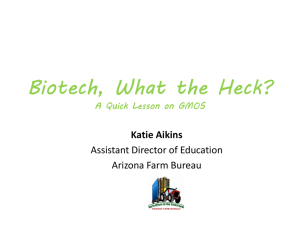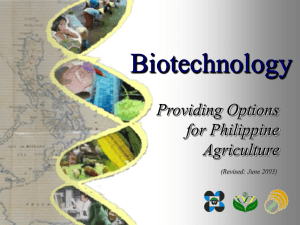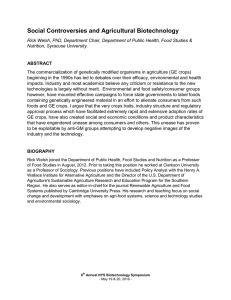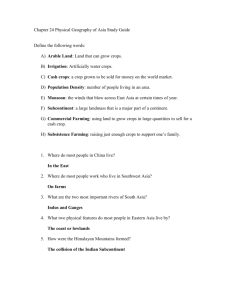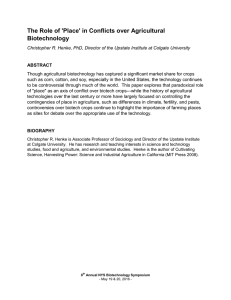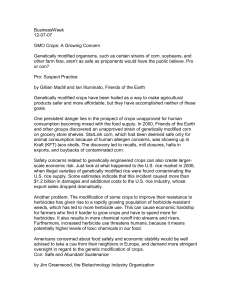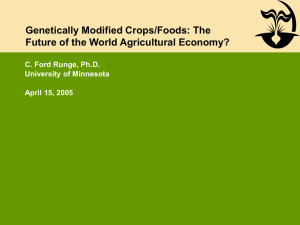Agricultural Biotechnology as a Tool for International Development Frank Shotkoski Cornell University
advertisement
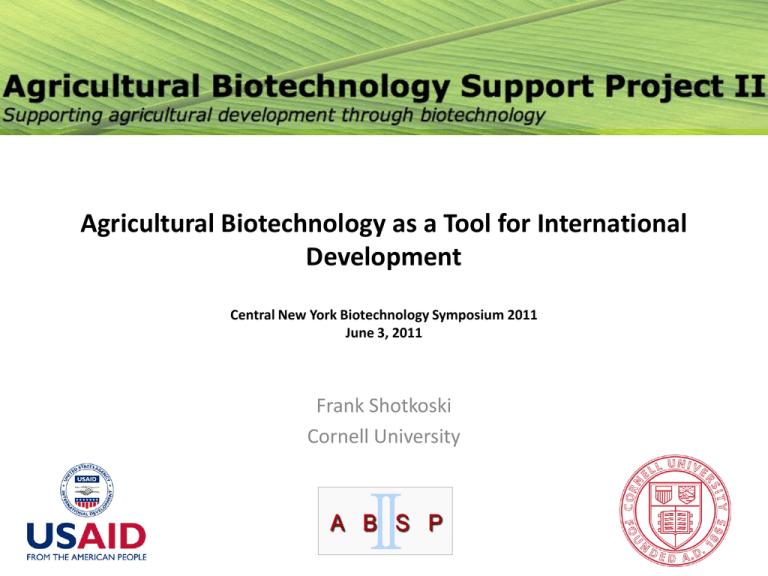
Agricultural Biotechnology as a Tool for International Development Central New York Biotechnology Symposium 2011 June 3, 2011 Frank Shotkoski Cornell University Global Challenges to Food Security Population growth • Increased demand for food • Increased demand for water & land resources Static or declining arable land • Urbanization, industrialization, soil erosion, rising sea levels, preservation Climate change • Rising temperatures • Changing precipitation patterns All crops have been genetically modified during domestication photo by Bruce Thomas, UC Davis Prehistoric farmers selected the genetic changes that domesticated certain wild plants. Modern plant breeders have selected additional genetic improvements to produce the crop plants that we enjoy today. teosinte / corn wild tomato / modern tomato Bringing Technology to the Farmer Multi-national crop protection companies • Focus primarily on a few crop/trait combinations that have high commercial value and occupy large international markets • Profit-driven, often creates controversy Public institutions • Limited resources, lack capacity and infrastructure, poor success to advanced technology (IP) Public/private partnerships • Royalty free access to advanced technology • Absorb regulatory and product development costs Global Area of Biotech Crops, 1996 to 2010: Industrial and Developing Countries ISAAA M Acres 395 160 346 140 Total 296 120 Industrial 247 100 198 80 148 60 99 40 49 20 0 0 Developing 1996 1997 1998 1999 2000 2001 2002 2003 2004 2005 2006 2007 2008 2009 2010 Source: Clive James, 2010 Global Area of Biotech Crops, 1996 to 2010: By Trait ISAAA M Acres 100 100 222 90 Herbicide Tolerance 198 80 Insect Resistance (Bt) 173 70 Herb Tolerance/Insect resistance 148 60 124 50 99 40 74 30 49 20 25 10 0 0 1996 1997 1998 Source: Clive James, 2010 1999 2000 2001 2002 2003 2004 2005 2006 2007 2008 2009 2010 Crop Countries and Mega Countries, 2010 ISAAA Agricutural Biotechnology Support Project (ABSPII) Publicly funded project designed to complement national ad regional efforts to develop and commercialize safe and effective bio-engineered crops in • Africa: Uganda • South Asia: India, Bangladesh • Southeast Asia: Philippines, Indonesia Product Demand Driven Strategy • Focus: to deliver the right genetically engineered products to farmers • Decisions based on solid socio-economic impact assessments • Deliver effective communication and outreach • Provide concrete examples to develop capacity – Licensing and policy issues (IP ownership, FTO, licensing, regulatory policy, etc.) – Biosafety policy and regulatory approval process – Product development (efficacy, variety performance) – Commercialization (seed distribution and stewardship) Major Strategic Elements • Build north-south and south-south public or public/private partnerships • Develop local marketing and distribution platforms • Promote and implement responsible stewardship practices • Economic development through ag biotech to help alleviate poverty and hunger ABSPII-Supported Projects • Disease and nematode resistant banana (Uganda) • Bollgard II cotton & Roundup Ready flex (Uganda) • Fruit and shoot borer resistant eggplant (India, Bangladesh, Philippines) • Late blight resistant potato (India, Bangladesh, Indonesia) • Papaya ringspot resistant papaya (Philippines) Biotech & Sustainable Farming Drought/salt tolerance • Hardier crops use water more efficiently to recover from stress and produce higher yields • More able to withstand weather extremes Pest control • Reduced pesticide applications • Lower or no-till crops mean less soil erosion Increased crop quality and yields • Biofortification (golden rice, oil quality) • Efficient nitrogen use www.absp2.cornell.edu Frank A. Shotkoski fas23@cornell.edu

